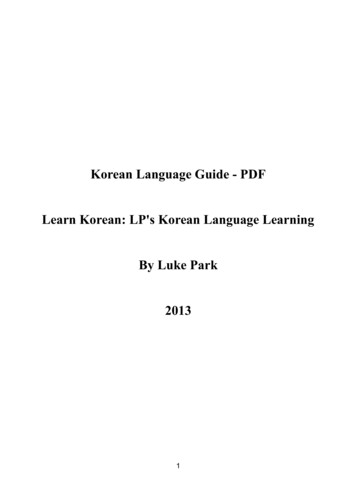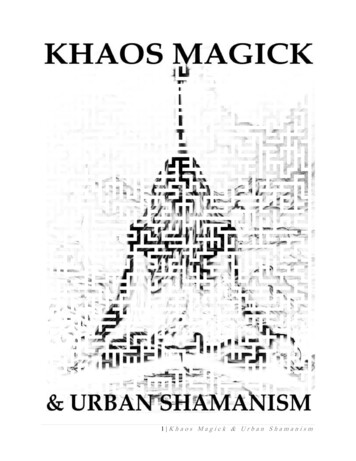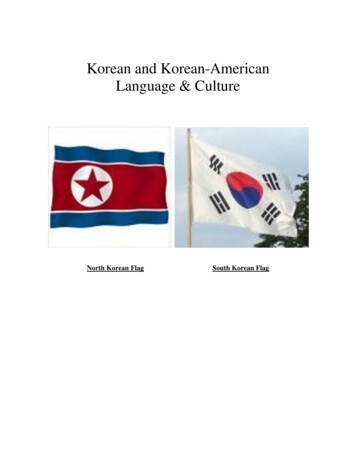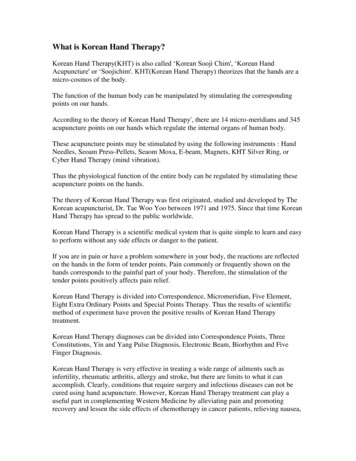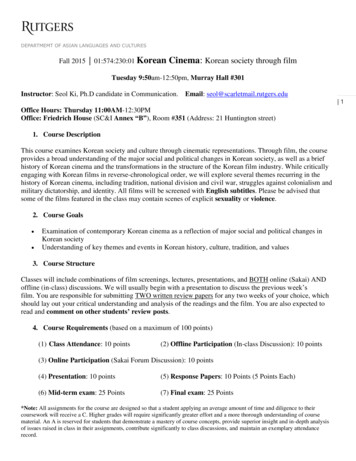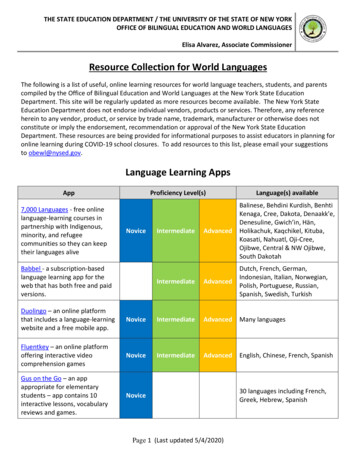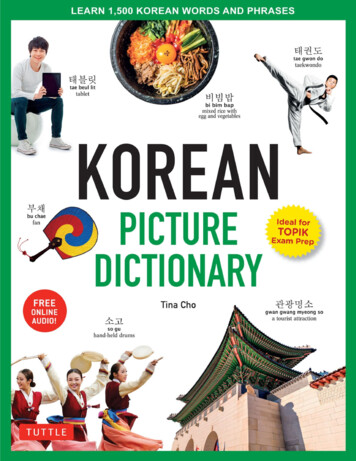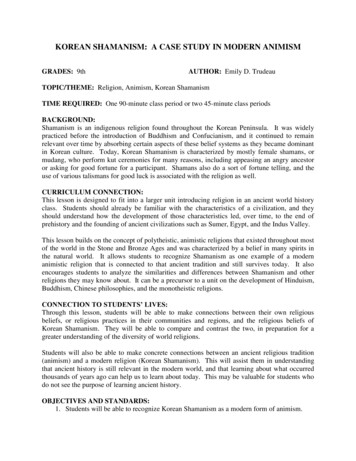
Transcription
KOREAN SHAMANISM: A CASE STUDY IN MODERN ANIMISMGRADES: 9thAUTHOR: Emily D. TrudeauTOPIC/THEME: Religion, Animism, Korean ShamanismTIME REQUIRED: One 90-minute class period or two 45-minute class periodsBACKGROUND:Shamanism is an indigenous religion found throughout the Korean Peninsula. It was widelypracticed before the introduction of Buddhism and Confucianism, and it continued to remainrelevant over time by absorbing certain aspects of these belief systems as they became dominantin Korean culture. Today, Korean Shamanism is characterized by mostly female shamans, ormudang, who perform kut ceremonies for many reasons, including appeasing an angry ancestoror asking for good fortune for a participant. Shamans also do a sort of fortune telling, and theuse of various talismans for good luck is associated with the religion as well.CURRICULUM CONNECTION:This lesson is designed to fit into a larger unit introducing religion in an ancient world historyclass. Students should already be familiar with the characteristics of a civilization, and theyshould understand how the development of those characteristics led, over time, to the end ofprehistory and the founding of ancient civilizations such as Sumer, Egypt, and the Indus Valley.This lesson builds on the concept of polytheistic, animistic religions that existed throughout mostof the world in the Stone and Bronze Ages and was characterized by a belief in many spirits inthe natural world. It allows students to recognize Shamanism as one example of a modernanimistic religion that is connected to that ancient tradition and still survives today. It alsoencourages students to analyze the similarities and differences between Shamanism and otherreligions they may know about. It can be a precursor to a unit on the development of Hinduism,Buddhism, Chinese philosophies, and the monotheistic religions.CONNECTION TO STUDENTS’ LIVES:Through this lesson, students will be able to make connections between their own religiousbeliefs, or religious practices in their communities and regions, and the religious beliefs ofKorean Shamanism. They will be able to compare and contrast the two, in preparation for agreater understanding of the diversity of world religions.Students will also be able to make concrete connections between an ancient religious tradition(animism) and a modern religion (Korean Shamanism). This will assist them in understandingthat ancient history is still relevant in the modern world, and that learning about what occurredthousands of years ago can help us to learn about today. This may be valuable for students whodo not see the purpose of learning ancient history.OBJECTIVES AND STANDARDS:1. Students will be able to recognize Korean Shamanism as a modern form of animism.
NCSS Standard: Theme I: CultureLearners will explore and describe similarities and differences in the ways groups,societies, and cultures address similar human needs and concerns.NC Standard: Competency Goal 8.01: Patterns of HistoryTrace developments in literary, artistic, and religious traditions over time aslegacies of past societies or as cultural innovations.2. Students will be able to compare and contrast Korean Shamanism with at least one otherreligion.NCSS Standard: Theme I: CultureLearners will explore and describe similarities and differences in the ways groups,societies, and cultures address similar human needs and concerns.NC Standard: Competency Goal 8.02: Patterns of HistoryCompare major Eastern and Western beliefs and practices, including but not limitedto Buddhism, Christianity, Confucianism, Hinduism, Islam, Judaism, andShintoism, and locate their regions of predominance.Common Core Standards:SL 1 Initiate and participate effectively in a range of collaborative discussionSL 2 Integrate multiple sources of information presented in diverse media or formatsMATERIALS REQUIRED: one man-made classroom object (such as a book, pencil, map, etc.) one object from the natural world (leaf, rock, flower, bird feather, etc.) six large pieces of large chart paper and tape to hang them around the classroom six markers of different colors six copies each of Handouts 1-6 (one copy of each handout for each of six groups) copies of Handout 7 for each student Optional Extension Activity: computer with internet connection, speakers, and projectorINTRODUCTION and EXPLORATION: Choose any man-made classroom object (book, pencil, map, etc.) and hold it up forstudents to see. Ask them if they believe this object has a spirit or a soul. They willprobably say no, but encourage discussion. Ask them to define what a spirit or a soul is. Choose any object from the natural world (tree leaf, rock, flower, bird feather, etc.) andask them the same question. Many will probably still say no, but again, encouragediscussion. Ask them if the two objects (man-made and natural) are different, and why. Point to yourself and ask them if they think you have a spirit or a soul. Most willprobably say yes. Ask them to define WHY they think that. If students do not bring upthe topic of religion themselves, mention that spirits and souls are usually connected toreligion, which is the topic for today’s lesson. Place six large sheets of paper around the room with the following questions on them:1. What is the definition of a religion?2. What are some religions you have heard of?3. What are some things that all religions have in common?4. Is religion important? Why or why not?
5. How do religions change over time?6. How is religion related to history? Why do we study religion in history class?Divide students into six groups. Give each group a different color of marker, and askthem to answer one of the questions on the large paper. Explain to them that they maynot KNOW the answer, so whatever they THINK is what they should write down.Give students time to answer the question, and then ask them to move on to the nextsheet of paper and the next question. They should take their markers with them so thatyou will know which group wrote what information. Repeat this until each group hasanswered each question.Once all students have returned to their seats, read through what they wrote as a classand discuss it, highlighting accurate information and correcting inaccurate informationas much as possible. This is designed as an introduction to the concept of religions, notan exhaustive lesson on religion itself.PROCEDURE:THE DELIVERY OF THE CONTENT:1. Using Question #2 from the introduction activity, help students to categorizereligions into monotheistic (one god) or polytheistic (more than one god).2. Explain that, as far as historians are aware, the oldest form of religion waspolytheistic, and that we usually called it animism (a religion in which most naturalmaterials and many forces of nature are believed to have a spirit or soul and toembody deities). Encourage students to give examples, like the god of the wind, orthe idea that trees are living beings.3. Ask students to speculate why this type of religion might have been the first to arisein the eras of prehistory and ancient civilizations; they should make connections tothe reliance of early peoples on the natural world.4. Ask students if they know anyone who practices animism or if they even think thatit still exists today. They will probably say no. Explain that there are many formsof animism that have existed for thousands of years and still exist today. One ofthese is Korean Shamanism, which they will learn about through a station activity.5. Divide students into six groups.6. Have copies of Handouts 1-6 distributed around the room in six stations. Have eachgroup of students start at one of the six stations.7. Provide time for students to discuss and answer each question, and then ask them tomove on to the next station. Repeat this until each group has visited each station.8. Depending on the level of your class, you may want to assign roles within eachgroup (leader, recorder, time-keeper, etc.).9. Optional Extension Activity: If you have access to technology, students can visit aseventh station to view a video of an actual kut ceremony at the following with-an-exorcist-koreanshamanism-unveiled/This site has an article about the author’s experiences, a short (1:54 minutes)YouTube video, and a link to photos that students can browse through.THE APPLICATION OF THE CONTENT:
1. Students will work in groups to answer the questions provided on each handout.Through these activities, they will become familiar with several aspects oftraditional and modern Shamanism.2. Throughout the station activities, students are asked to draw conclusions, analyzeinformation, and make connections between Shamanism and other religions.3. If time permits, a class-wide discussion of the information presented at each stationcan help students to solidify their ideas. Alternatively, each group’s work can becollected for later verification.ASSESSMENT:1. Once students have worked through all of the stations, ask them to individually completethe Venn diagram and answer the key question in Handout 7.2. Students should use the Venn diagram to compare Korean Shamanism to any otherreligion of their choice. The format of the diagram allows students to list similaritiesand differences; assign a minimum number of each category that you expect completed.3. A review of the students’ Venn diagrams and key question answers should revealwhether they can accurately compare Korean Shamanism to other world religions andconnect it to ancient animist traditions.RESOURCES:Caraway, Bill. “Korea in the Eye of the Tiger.” Last modified August 6, 2006. AccessedAugust 15, 2011. Choe, Sang-hun. “Shamanism Enjoys a Revival in Techno-Savvy South Korea.” New YorkTimes, July 7, 2007. Accessed August 2, 07korea.htmlClark, Donald N. Culture and Customs of Korea. Westport, Connecticut: Greenwood Press,2000.DeMarco, Peter. “Date With an Exorcist: Korean Shamanism Unveiled.” Accessed August 1,2011. -an-exorcist-koreanshamanism-unveiled/.Doménech del Río, Antonio J. “Gut: Korean Shaman Ritual.” List: Books from Korea 11(2011). http://www.list.or.kr/articles/article view.htm?Div1 7&Idx 630.Fenkl, Heinz Insu. “Dancing on Knives: An Introduction to the Politics of Sexualityand Gender in Korean Shamanism.” Accessed August 1, 2011.http://heinzinsufenkl.net/knives.html.Kim, Eungi. “Understanding Korean Culture: Its Symbols, Language, Norms, and Values.”Paper presented at the Korean Studies Workshop, Korea University, Seoul, Republic ofKorea, June 28, 2011.Kim, Yoo-kyung. “Praying for the Mercy of the Goddess of Wind: Yeongdeung Shaman
Rites.” Koreana: Korean Culture & Arts 25 (2011): 22-27.“Sanshin: The Mountain Spirit.” Accessed August 15, .html.
HANDOUT 1: THE SANSHINLook at the picture below. Work with your group to answer the questions underneath.Painting of Sanshin Mountain Spirit at T’aebaeksan Gakwonsa(photo from “Sanshin: The Mountain Spirit;” see “Resources”)1. The Sanshin is a mountain god or spirit in Korean Shamanism. What do you see in thispicture that shows his connection to nature?2. The Sanshin is almost always shown as an old man with a long beard. Why do you thinkKoreans picture their mountain god as an old man?3. The Sanshin is always shown with a tiger and a pine tree. What do you think the tigersymbolizes? What do you think the pine tree symbolizes?4. Why do you think that the Sanshin, or mountain god, is one of the most important gods inKorean Shamanism? What does it tell us about Korean beliefs?
HANDOUT 2: THE STORY OF TAN’GUNRead the following story. Then work with your group to answer the questions.Korea was founded many years ago, in a time when animals could speak like humans. One day,the great Lord of Heaven received a visit from his son, Hwan-ung. Hwan-ung requestedpermission to leave the heavens and start a life on earth. His father gave him permission, and hedescended to earth at the top of a mountain on the Korean Peninsula. There he established acity and became a wise and happy ruler.After many years, a bear and a tiger came to visit the ruler, Hwan-ung. They had an unusualrequest: they both wished to become human. Hwan-ung was surprised, but he agreed to granttheir wish, as long as they could follow some simple directions. He told them that they must stayin their cave for the next 100 days, with only a tiny amount of food. The bear and the tigerquickly agreed, and they went to their cave, where they remained peacefully for 20 days.However, on the 20th day, the tiger could no longer live with his hunger, loneliness, andboredom. He gave up on his quest to become human and left the cave.The bear remained behind, and although she suffered greatly, at the end of the 100 days, she wastransformed into a beautiful woman. She went to thank Hwan-ung, who fell in love with her.They married and had a son, who was named Tan’gun. He became the leader of the Koreanpeople and founded Korea in the year 2333 B.C.E.1. Why do you think the bear and the tiger in this story wanted to become human? What doesthis tell us about the relationship between humans and nature in Korean Shamanism?2. Tan-gun is believed to be the founder of Korea. Why is it significant that his mother wasoriginally a bear?3. Why is it significant that Tan’gun’s father was a god, the son of the Lord of Heaven?4. Mudang are people who communicate with the spirits in Shamanism. Tan’gun is sometimesseen as the first mudang. Why might Tan’gun be a good mudang?5. This story is an example of a creation myth, a story that is used by a group of people toexplain where they come from. What other creation myths have you heard of? Are there anysimilarities between those stories and the story of Tan’gun?
HANDOUT 3: SHAMANIST SYMBOLSLook at pictures below. Work with your group to answer the questions underneath.Picture #1: wooden village guardians atThe National Folk Museum of Korea in SeoulPicture #2: stone offering piles at PulguksaTemple outside of Kyŏngju1. Picture #1 shows examples of carved wooden figures that traditionally would have guardedthe entrance to a village. Do these guardians look friendly or frightening? Why?2. Village guardians can be seen as either a superstition (like a lucky rabbit’s foot) or aShamanistic religious belief. Which one do you think they are? Why?3. Picture #2 shows some of the hundreds of small stone piles located in a Buddhist temple inKorea. These stone piles are Shamanist, not Buddhist; why do you think they are found in aBuddhist temple?4. The stone offering piles represent the wishes of many people. Why do you think Shamanistsuse stone piles to represent their wishes?5. How do you think the wishes of Korean Shamanists have changed?prehistoric Korean wish for? What would a modern Korean wish for?What would a
HANDOUT 4: THE SPIRITSRead the following information. Then work with your group to answer the questions.The religious leader of Shamanism is called a shaman, or a mudang. Another name for thisperson is a manshin. The word manshin means “10,000 gods.” Most mudang in Korea arewomen.There are many spirits in the world of Shamanism. There are nature spirits like wind, water, andtrees. Many Koreans are very respectful of trees; some trees in Korea are more than 700 yearsold, and they are not allowed to fall down or die.There are spirits of people. Some of these are ancestors, relatives who have died already. Somewere brave and noble and are treated like heroes. Others died violent or tragic deaths and cancause trouble for the living.There are also spirits related to specific places, like house spirits or mountain spirits. ManyKoreans place stone offering piles in mountainous areas, and there are often shrines to theSanshin, or mountain god.1. Why do you think that the mudang is sometimes called “10,000 gods”? What does this tellus about his/her responsibilities?2. What evidence do you see in the information above that Shamanism is an animistic religion?3. One of the characteristics of a religion is that it demonstrates a belief in an afterlife(something that happens to you after you die). What kinds of spirits show evidence thatShamanists believe in life after death?4. Why do you think most shamans, or mudang, are women?5. Most religions have holy places (churches, mosques, temples, etc.). How are Shamanism’sholy places similar? How are they different?
HANDOUT 5: THE KUT CEREMONYRead the following description of a kut. Then work with your group to answer the questions.The main ceremony of Shamanism is the kut, led by a shaman or mudang. This ceremony can beperformed for several reasons, but it is often used to communicate with the spirits of ancestors,or to ask for good fortune from different spirits and deities. A traditional kut has five parts:1. The area in which the kut is going to be performed has to be purified by the shaman, ormudang. She (most shamans are women) does this using incense and water.2. The mudang invites the spirits to participate in the ceremony. This usually involvesdancing and singing.3. The mudang then establishes a connection with the spiritual world, often by going into atrance. While she is in a trance, the spirits that possess her can speak through her.4. Through the mudang, participants in the kut can communicate with the spirit world. Thishelps them to discover if there are angry spirits causing them harm, or if their ancestorsare happy.5. At the end of the ceremony, the mudang says good-bye to the spirits. She can burn paperdecorations to send them away, and there are usually offerings of food and drink.During the kut, the mudang may wear many different outfits, including men’s clothes, torepresent the different spirits she is speaking to. She will likely sing and dance, and she mayperform feats that seem miraculous. One example is of a mudang balancing a whole dead pig onthe end of a knife. Another common practice is the use of different colored flags. Participantseach pull one of the flags from a bundle, and the color indicates whether they can expect positiveor negative results from their requests during the kut.1. During a kut, modern Korean participants usually ask for material wishes (like money). Howdoes this compare to what people in other religions pray for?2. The best color of flag to choose is usually red or blue, and the worst is usually white. Howwould you feel if you chose the white flag? Why?3. The mudang uses the kut to communicate with spirits. Is this the same as other religiousleaders praying to a god or gods? Why or why not?4. This description tells of a modern kut, taking place in the 21st century. Is this similar to ordifferent from other modern religious ceremonies? How?
HANDOUT 6: MODERN SHAMANISMRead the statistics and information below. Then work with your group to answer the questions.There are many religions in Korea; the most popular are Buddhism and Christianity.Shamanism is one of Korea’s religions, but most Koreans claim that they are not shamanistic.There are over 300 Shamanist temples within an hour of Seoul, the capital of South Korea, andthere are as many as 300,000 mudang, or shamans, who perform ceremonies.Part of Shamanism is the use of fortune-tellers who can communicate with spirits and ancestorsto help believers make important decisions. When surveyed, 72% of Koreans say that they havevisited a fortune-teller at least once. Fortune-tellers can be used to predict the happiness of amarried couple, choose lucky names for babies, pick auspicious days for important events, orprovide a number of other services.Of those who have visited a fortune-teller, 69% have carried a talisman (or good-luck charm)with them at some point in their lives. Some people use electronic talismans on their cell phones.Shamanism has adapted to the modern world. There are many fortune-telling cafés, like coffeeshops, where people can have a snack or a drink and get their fortune told at the same time.There are also more than 1000 fortune-telling websites.(Statistics from Choe, Sang-hun, and Kim, Eungi; see “Resources”)1. Many Americans think of fortune telling as a superstition. How does the belief in ancestorsand other spirits make fortune-telling a religious practice in Shamanism?2. Why do you think most Koreans say that they do not practice Shamanism, even though mostof them have practiced it at least once in their lives?3. What does the use of electronic talismans and fortune-telling websites tell us about howShamanism has adapted to the modern world?4. Have you ever had your future told? If you were told your future, would you believe theperson telling you? Why or why not?
HANDOUT 7: VENN DIAGRAM ASSESSMENTKEY QUESTION: Is Korean Shamanism a modern form of animism, the religion that prehistoric people and ancient civilizationspracticed? Why or why not?VENN DIAGRAM: Can you compare Korean Shamanism to another religion? You may choose any other religion you want tocompare to Shamanism. Write “Shamanism” above one circle and the name of the other religion above the other circle. For fullcredit, you must include at least similarities in the middle section of the Venn diagram and differences on the sides.
Aug 15, 2011 · KOREAN SHAMANISM: A CASE STUDY IN MODERN ANIMISM GRADES: 9th AUTHOR: Emily D. Trudeau TOPIC/THEME: Religion, Animism, Korean Shamanism TIME REQUIRED: One 90-minute class period or two 45-minute class periods BACKGROUND: Shamanism is an indigenous religio


